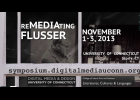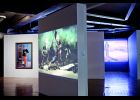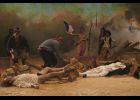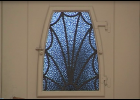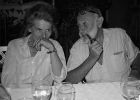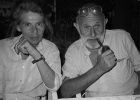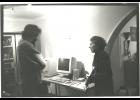Flusser Studies 18 - November 2014 / Proceedings of the symposium „Remediating Flusser“ (November 2013)
“The Lens is to Blame”: Three Remarks on Black Boxes, Digital Humanities, and The Necessities of Vilém Flusser’s “New Humanism”
This paper offers a brief exploration of Vilém Flusser’s proposed yet undeveloped concept of “new humanism” and argues for the centrality of the concept for a distinct ethical-political track that winds its way through all of his writings on communication, media, and technology, in addition to his explicit references to exile and nationalism. Because changing technologies circumscribe the field of possibility for human activity, the analysis of technology then becomes a matter of anthropology. By placing these questions at the center of his inquiries into communications and media, Flusser re-conceives the human subject itself, ensuring that his “new humanism” is not a return to any established version, but will reckon with the fact that technological development prompts changes in the definitions of the human itself. I also consider his demand for a new humanism an exemplary case for a relation to the master terms of the Enlightenment and humanistic investigation in the digital age, which persists after digitality even as they are recoded.
Drafting the Techno-Imagination: A Future for Literary Writing?
Vilém Flusser paints a dire picture for the future of literary writing. He contests that it is doomed to be replaced by automated language games. In that sense, one can see literature and the image-culture as antagonistic forces. Drawing on examples from contemporary German literature, however, I show in which ways the literary imagination may contribute to the formation of the techno-imagination. The authors Ulrike Draesner and Thomas Lehr scrutinize the impact that visual media has on conceptual thinking and identity. Core ideas from Flusser’s media theory, such as the photographer as homo ludens, communication as resistance to natural entropy, and the re-conceptualization of space and time, feature prominently in the two 2005 novels Spiele (Games) and 42. In these texts, the imaginative capacity of fictional literature provides a conceptual space in which a new awareness towards technical images is drafted, tested, and reviewed.
What Can Arnheim Learn from Flusser (and Vice Versa)?
This paper fills a gap in Flusser scholarship by conducting an initial comparison of Flusser with Rudolf Arnheim. After noting their similar approaches – open both to science and phenomenology – it looks closely at each theorist’s respective theory of photography. They differ in that Flusser believes that the photography as a technical apparatus is not objective. However, with some contextualization each can be seen to say complementary things. Reflecting on each theorist’s cautiously optimistic or pessimistic approach to evolving media, the paper concludes with thoughts on how they give helpful ideas on how to flesh out aspects of the other’s thought.
Vilém Flusser’s Theories of Photography and Technical Images in a U.S. Art Historical Context
In the field of U.S. art history, the photography specialization is fairly new and the discourse is dominated by a handful of voices like Walter Benjamin and Roland Barthes, while Vilém Flusser has been virtually ignored. This essay examines the trilogy of “technical image” texts Flusser wrote in the 1980s—Towards a Philosophy of Photography (1983), Into the Universe of Technical Images (1985), and Does Writing Have a Future? (1987)—and beyond these, locating the seeds of Flusser’s “photophilosophy” in his use of information and communications theory to develop concepts like “image,” “apparatus,” “program,” and “information.” It considers the U.S. art historical bias toward writers like Jean Baudrillard, Paul Virilio, and the “control society” ethos of Gilles Deleuze and Flusser’s proposal that technical images and photography criticism could provide models for creative disruption of apparatus and finally, “human freedom.” Placed in the current moment, with its crises of environment, technology, economy, and geopolitics, this essay considers Flusser’s writing as a form of ethics and politics in which photography serves as a model for thinking about history, culture, revolution, and consciousness.
X: The Gesture of Essaying
Drawing upon Flusser’s sketch of “being-in-the-skin”, this essay explores the significance of the dialogical form of chiasmus for Flusser’s conception of gesture, arguing for an understanding of his “gesture of writing”, as a gesture of essaying, wherein a “poetic subject” is manifested – one who is born to understanding, gestated, in the process of conversing in-between, where “meaning” is organised through rhythm. The essay itself sets up this argument through a gesture of essaying, placing Flusser into conversation with a broader discourse on writing and gesture.
The Black Box and the Techno-Imagination of the Sublime: Flusser, Kant, and Iñarritu’s 11’09”01
Despite the possibility for “meta-programming,” the relationship that the photographer maintains to the apparatus in Flusser’s theory is one in which the latter not only conditions the processes of image making and viewing, but perpetuates the larger cultural framework of the technical image. Acting as a materialization of a larger discursive regime, the camera oversees and manages micro- and macro- distributions of the program of which it is a part. This essay attempts to draw out the larger implications of this model by engaging with disaster photography, specifically, the seeming ubiquitous impulse to take pictures in the context of 9/11. Rather than the ineffable of the sublime or unassimilable of trauma studies, Flusser’s ideas allow us to approach this scenario from a materialist framework, suggesting a unique camera consciousness of disaster which functions as a specific category within its larger program rather than its compromise or negation.
Post-History, technical images and freedom in times of barbarism
Amongst the various media theorists who emerged in the last century, Walter Benjamin and Vilém Flusser are unquestionable references in regard to issues related to the narratives and the world of images. In addition to thinking about media devices and apparatuses beyond technical objects, both Benjamin and Flusser considered media images as concepts that articulate new epistemological and ontological views of the world.
On the other hand, it is possible to identify in both theorists thought processes that engage the concept of history with different perspectives. In line with critiques of a universal and hegemonic history, and without falling into an apologetic discourse about a presumed end of history, these authors offer us fresh perspectives in relation to historicism through a fruitful dialogue with the realm of technical images.
Post-history, technical images, and freedom in times of barbarism focuses not only upon contributions by Walter Benjamin and Vilém Flusser, but the article also examines the curatorial perspective of Arquivo Vivo, showcased at the Paço das Artes, in São Paulo, in 2013. This exhibition highlights the central position of art in the production of knowledge about images, history, and narratives within the framework of contemporaneity.
6 PHOTOGRAPHS: Partial views of the exhibition "Arquivo Vivo", Paço das Artes, 2013, curated by Priscila Arantes. Photos by Fernanda Frazão, courtesy of the Paço das Artes
The pearls, as I wrote you
Immigrants from Bolivia, Peru, Colombia, Argentina, Congo, and Guinea who entered illegally to Brazil and now live in Sao Paulo, are invited to read excerpts from Americo Vespucci's Mundus Novus. Written between 1503 and 1504, the letter is taken as an inaugural discourse on the New World addressed to Europe. From the particular accent and intonation of each immigrant comes a polyphony that questions the condition of the foreigner and discusses the meaning and contradictions of living between two frontiers, as well as the power relations and cultural violence that a foreign language imposes.

